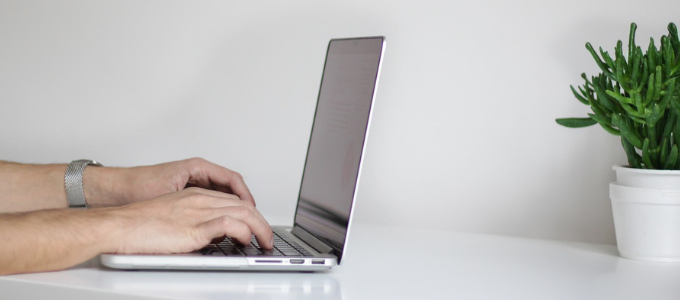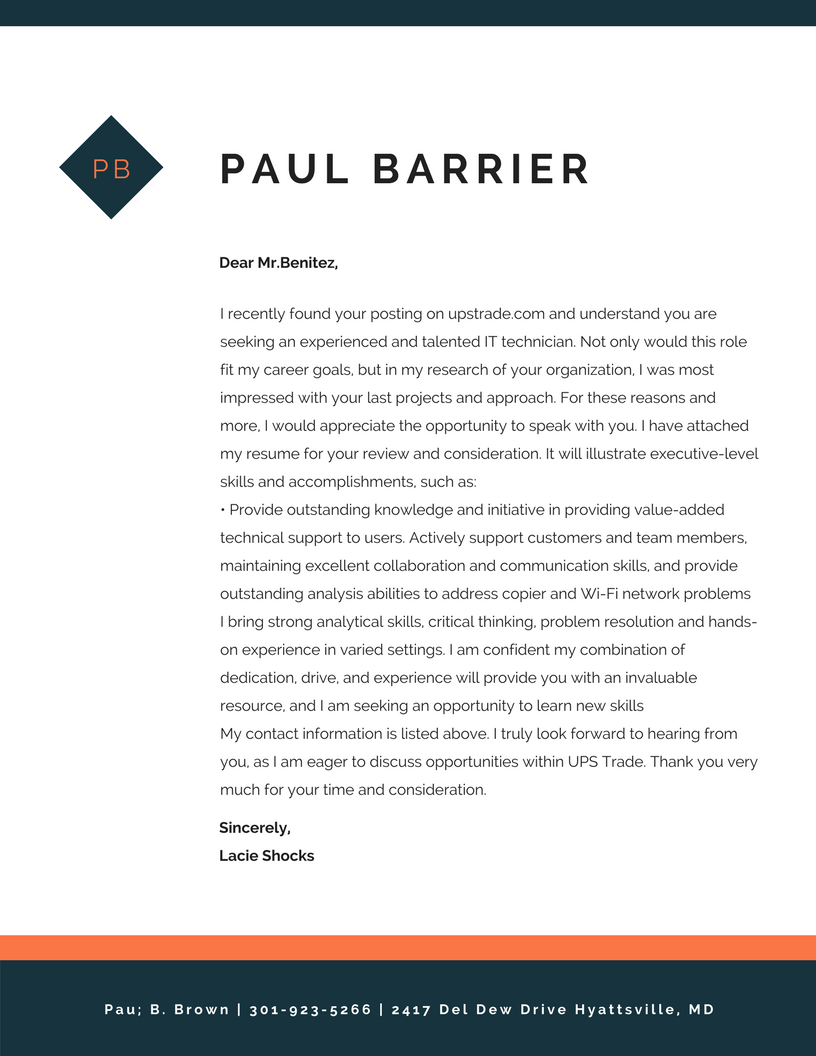How to Layout a Cover Letter to Make It Perfect

When applying for a job, especially for the first time in their life, job hunters need to possess certain skills for writing good cover letters.
A cover letter is a document written by a job applicant who is submitting a CV applying for a new job. The CV and cover letter are aimed at complementing each other. They have to provide the most crucial and additional information respectively.
The layout of this document is as important as its content. It refers to the rules of setting up the words and paragraphs on the page, choosing appropriate headings, spacing, font, etc. In this article, you will find useful tips on how to layout the cover letter, as well as an example of it.
What Is a Layout of Cover Letter?
A cover letter is a type of the document a job applicant sends alongside the CV to apply for a job. In the cover letter, a person can introduce himself/herself while, in the CV, only the most key information is provided. This document should complement the CV but not duplicate it.
Layout of a CV differs greatly from the cover letter. Check how to select the best variant here.
In many countries, a cover letter is not necessary but, in the United Kingdom, it is obligatory. So, here we are going to talk about how to write a cover letter UK layout.
A cover letter helps you explain to an employer why you are the most suitable candidate for the particular position. In the document, you need to highlight the most relevant skills and experience. The job applicant needs to imagine that he is already working on the dreamed position and write the cover letter with this thought in mind. Or devote the task to the professional cover letter service online and take it easy.
How Should a Cover Letter Be Addressed?
You have to address your cover letter directly to the hiring manager or someone who will be responsible for hiring you. Be sure you have found the right contact name. In case, you were not able to find a contact name, you can use a general salutation. These can be, for example:
- Dear Sir/Madam
- Dear Hiring manager
- Dear Human resources director, etc.
It is strongly advisable to search the company’s website for details of the hiring manager. While many job applicants are afraid to do this, a good idea is to call the organization to ask the name of the person in charge. It will save a hiring manager a headache and time.
Remember that the general greetings can be used only if you cannot find a named contact. When addressing to the exact person instead of an organization, you make a better impression.
Tips for Writing a Good Cover Letter
Employers may receive a lot of applications for their vacancies. However, your task is to create your layout of a cover letter so that it could make a lasting impression on the employer. A good cover letter increases your chances of success.
Making a favorable first impression by writing a cover letter for CV is highly important as this is your first contact with a hiring manager. That’s why it is crucial to create a document that will sound professional. At the same time, it has to encourage the employer to take a look at your CV.
So, here are some helpful tips to make your hiring manager sure that you are a highly skilled and enthusiastic professional. Show that you are genuinely interested in working in the offered position.
Tip #1. Be Concise
In general, the length of this kind of document should be no more than a half of a page of A4 or at least it should not exceed one A4 page.
Remember that the shorter your document, the better.
When writing about our skills and experience, we usually tend to be generous in words. After you wrote the cover letter, read it again and cut out words and sentences that your employer might find needless.
Also, don’t clog your cover letter up with an unnecessary personal information. There actually should no more than three to five short paragraphs that in total will take no more than one A4 page. If you are going to send your cover letter by email, better put the text of the document in the email rather than as an attachment because it can be lost.
Tip #2. Tailor to the Specific Organization
Even if you are applying for similar positions, the jobs and organizations cannot be the same. To stand out from the crowd, search for the organization on the internet. Address your application to the individual company and demonstrate your knowledge of the firm.
Whenever you apply for a new position, write a new cover letter. Layout your document according to your future duties. Invest some time to customize your cover letter to the specific position summarising your strengths.
Tip #3. Make Your Cover Letter Layout Professional
Since the cover letter is aimed at making a great quick impression, every word you write has a huge impact on the overall result. Whenever you are writing a cover letter layout, you need to make it easy to read as well as businesslike and professional. This is a good chance to let your employer create a good opinion about you on the basis of your tremendous communication skills.
To impress the hiring manager, identify your unique selling points. Show that you are the perfect candidate for the position by being positive. Describe shortly which way your skills and experience meet those requested in the job ad. In addition, you should always have a professional tone. However, do not make it extremely formal as the employer will think that you will not suit an informal environment and work with a creative team.
Tip #4. Proofread
One of the most important tips is to spellcheck your cover letter. However, do not rely only on the online grammar checkers that seem to never pick up all mistakes. Better double-check your cover letter for spelling and grammar mistakes yourself. Also, ask a family member or friend to go through the document one more time to proofread and edit it. If you need, read it aloud.
Your cover letter layout can be written highly professionally, but even one mistake can decrease your chances of getting an invitation for a job interview. Also, remember to check carefully the company name and your contact details.
How to Format Your Cover Letter Correctly?
The way you format your cover letter is as important as the words you choose to build the sentences. In order to get your cover letter formatted properly, use the appropriate font, headings, and spacing.
The font and size should be the same as in your resume. Make sure to use a good quality paper to print the cover letter on. It is important to leave the space between the heading, greeting, paragraphs, closing, and signature. The entire cover letter should be single-spaced. The font should be as simple as possible as your document should remind a business letter.
As for the tips on how to layout a cover letter, skip those flowery and difficult to read fonts. Instead, choose some traditional and basic black fonts like Courier New, Times New Roman, Arial, Verdana. The font size should vary from 10 to 12-pt.
The tip here is not to be too scrupulous and choose a font size no smaller than 12-pt. You probably don’t want to make a hiring manager put aside your cover letter just because of a too irritating font. Also, remember to left-justify your document with the exception of the section that includes your name, address and contact information. This data can be put at the top right-hand corner of your document.
How to Layout a Perfect Cover Letter
Even if you possess many useful skills, the cover letter should be brief and emphasize your suitability for the specific position. It can consist of the following sections:
- Contact Information. The first section of your cover letter should include information about you and employer. If you don’t have the employer’s contact information, you can just provide your information. Single space and left justify this section. Put a space between these two sections. List your and employer’s contact information the following way:
Your Contact Information
Your Name
Your Address
Your City, State Zip Code
Your Phone Number
Your Email Address
Date
Employer Contact Information
Name
Title
Company
Address
City, State, Zip Code
- Salutation. This section is short while no less important than the other ones. Make sure to search on the internet the name of the hiring manager. If you are not able to find any contact name, use some polite expressions. You can use Dear Sir/Madam, Dear Hiring manager, Dear Human resources director and other.
- First Paragraph. Single space the first and the following body paragraphs of your cover letter. The first paragraph should include information on the position you are applying for and a job title. It is recommended to explain where you saw the job advertisement and what attracts you to this job. Also, you can write why you are interested in working for the chosen company and why you think you are the perfect candidate for this job. Also, let your employer know when you are available to start.
- Middle Paragraph(s). In the middle section, provide your employer with your skills, qualifications and working experience. Since cover letter should not simply duplicate your resume, do not clutter it with all the skills you possess. Write only about those relevant to the advertised position. Also, explain which way they can benefit the company. The second paragraph should fill the possible gaps in the CV.
- Final paragraph. Reaffirm that you find this job a wonderful opportunity and include one more time your contact information. Finish your cover letter by thanking the hiring manager for considering you for the position. To finish, say how you are looking forward to receiving a response.
- Closing and signature. Make sure to include these final parts. The way you sign off the cover letter depends on the way of addressing it. If there is no contact name, sign off the cover letter layout UK ‘faithfully yours’. If you were able to find a contact name, use a phrase ‘sincerely yours’.
Sincerely yours,
Handwritten Signature (for a mailed letter)
Typed Signature
Cover Letter Layout Samples and Examples
The cover letter example may serve as a layout for a typical cover letter. You can use it to word, structure, and space your document, learn which fonts to use and how to justify the text.
Using the template you can be flexible. Add or remove statements in order to fit the requirements of the specific job advertisement. Bear in mind that it is better to write a unique and customized cover letter for each job.
Address the job application to the specific organization to show that you are really interested in the position. Take a look at one of the possible cover letter layout examples for inspiration.

Conclusion
Hope these cover letter tips will assist you in creating a perfect cover letter that will increase your chances of getting your dreamed job. Use this template to help you begin writing your own cover letter. Include information about your own career history, skills, qualifications and experience.






